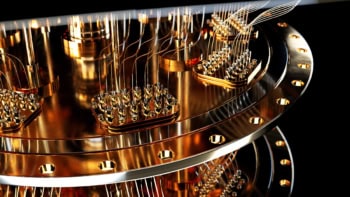Physicists in the US have taken another step towards the dream of a quantum computer by entangling two superconducting quantum bits (or qubits) for the first time. Circuits made from superconducting elements are promising candidates for a real quantum computer because they are compatible with conventional methods for making integrated circuits (Science 313 1423).

In the weird world of quantum mecahnics, particles can be “entangled” so that they have a much closer relationship than allowed by classical physics. For instance, two photons can be created in an experiment such that if one is polarized in the vertical direction, then the other is always polarized horizontally. By measuring the polarization of one of the pair, we immediately know the state of the other, no matter how far apart they are.
This “spooky action at a distance”, which has no classical analogue, could allow multiple bits of information to be processed at the same time in a quantum computer. Such a device could therefore outperform a classical computer by many orders of magnitude. There are currently many rival ways of entangling particles, for example by trapping ions at ultra-low temperatures and manipulating their internal energy states with lasers
However, demonstrating entanglement is hard. In particular, the particles, or qubits, have to be sufficiently isolated from the environment so that the fragile entangled state exists for long enough to allow a calculation to be carried out. Various other conditions also have to be met — together known as the “DiVincenzo criteria” — such as being able to measure both qubits at the same time.
Now, however, a team from the University of California, Santa Barbara, has successfully entangled two superconducting qubits for the first time. Electrical circuits made from superconductors are promising candidates for a working quantum computer because they can be made from thin films using conventional microchip fabrication technology. Coupling can be achieved simply by electrical connections between qubits – far easier than the trapped ion approach, where ions need to be shuttled about so they can interact.
Matthias Steffen and colleagues at Santa Barbara were able to entangle two qubits, each made from a Josephson tunnel junction, that meet the DiVincenzo criteria completely with a precision of 87% of theoretical values. The researchers used a delicate method known as “quantum state tomography” to confirm the entanglement, whereby a series of different parameters are measured for the two particles and used to reconstruct the quantum state, much as image “slices” are captured and combined into a three-dimensional picture in tomographic medical imaging.
Although physicists have been able to entangle up to eight ions at the same time — whereas the present work entangles just two quibits — Steffen insists superconducting qubits are a viable approach towards quantum computing. “Substituting some of the materials in the fabrication process should translate to a straightforward improvement of our results and in the long run, continued materials research should also help improve qubit performance,” he says.
The work was done by Santa Barbara’s Quantum Computation research group, which is led by John Martinis.



